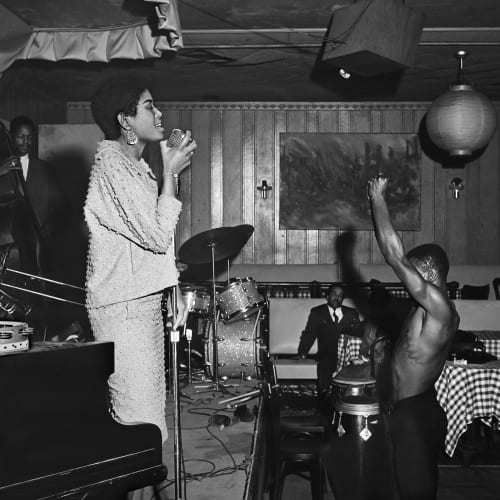Part of the “Black is beautiful” movement during the civil rights era, he trained his camera on athletes, musicians and models as well as everyday people.
Kwame Brathwaite, a photographer whose visceral, often elegiac pictures of cultural figures like Muhammad Ali and James Brown, along with Black fashion models and ordinary citizens, were hailed as a catalyst of the “Black is beautiful” movement of the 1960s and beyond, died on April 1. He was 85.
His death, in a Manhattan hospital, was confirmed by his son Kwame S. Brathwaite Jr.
As a freelance photojournalist for Black publications like The New York Amsterdam News, The City Sun and Essence magazine, Mr. Brathwaite chronicled the struggles of the civil rights era in his native New York. But he also traveled the world to file dispatches from the front lines in the battle for Pan-African unity.
In 1972, he captured Wattstax, the music festival in Los Angeles that has been called the Black Woodstock, with headliners like the Staples Singers and Isaac Hayes. In 1974, he traveled to Africa to shoot the brutal glory of the heavyweight boxing championship match between Muhammad Ali and George Foreman in Kinshasa, Zaire, now the Democratic Republic of Congo. That same year, he accompanied the Jackson 5 on their first trip to Africa.
Tanisha C. Ford, a historian at the University of Delaware, wrote of Mr. Brathwaite in the photography magazine Aperture in 2017, “His images, carefully calibrated to reflect a moment precisely, made Black beautiful for those who lived in the 1960s, and continue to do so for a generation today who might only now be discovering his work.”
An activist as well as an artist, Mr. Brathwaite was not content merely to observe through his camera’s viewfinder the strides that Black America was making. Taking cues from Marcus Garvey, the early 20th-century Black nationalist leader, he helped found, with his older brother Elombe Brath, the African Jazz-Art Society & Studios in 1956, when he was only 18.
The organization, which promoted concerts in jazz caldrons like Smalls’ Paradise in Harlem and fostered other Black cultural ventures in the neighborhood, was explicitly political, banding together the African Nationalist Pioneer Movement, led by Carlos A. Cooks, a disciple of Garvey’s, while also fighting for Black liberation in South Africa and other causes.
In 1962, the two brothers took another step toward merging Afrocentric politics with Black aesthetics, helping to found Grandassa Models. A collective of New York artists and activists, it promoted music, art and fashion of African heritage as well as the distinctive beauty of Black models, who displayed a wide variety of skin tones and features and wore a natural Afro hairstyle, as opposed to processed, often straightened, hairstyles borrowed from white culture or imposed by it.
Such efforts came together on Jan. 28, 1962, when the African Jazz- Art Society held a fashion show featuring music, dance and spoken- word performances at Purple Manor, a nightclub on 125th Street in Harlem. The name said it all: Naturally ’62: The Original African Coiffure and Fashion Extravaganza Designed to Restore Our Racial Pride and Standards.
The show, enlivened by a house band led by the luminary jazz drummer Max Roach, proved so successful that it became a biannual event and a showcase for Black fashion designers. It was also a celebration of Black culture as well as a critique of Eurocentric standards often centered on images of lighter-skinned Black Americans that were prevalent in popular culture at the time. As a result, Naturally was boundary-pushing enough to cause a stir, even within the Black community.
“There was lots of controversy because we were protesting how, in Ebony magazine, you couldn’t find an ebony girl,” Mr. Brathwaite told Dr. Ford in the Aperture article.
Gilbert Ronald Brathwaite was born on Jan. 1, 1938, in what he often called “the People’s Republic of Brooklyn.” He was the middle of three sons of Cecil and Margaret (Maloney) Brathwaite, immigrants from Barbados. His father was a tailor who came to own several dry- cleaning businesses.
Mr. Brathwaite adopted the name Kwame in the early 1960s, a tribute to Kwame Nkrumah, the first leader of post-colonial Ghana.
The family moved to Harlem when Mr. Brathwaite was a child, before settling in the South Bronx. A standout student, he attended the School of Industrial Art (now the High School of Art and Design) in Manhattan. He was mulling a career in graphic design when, at 17, he saw a searing image that would change the course of his life.
The photograph was of the mutilated body of Emmett Till, the 14-year-old from Chicago who had been tortured and killed by white men while visiting relatives in Mississippi, supposedly for flirting with a white woman. Emmett’s mother’s decision to display this horror to the world — the photo, by David Jackson, was first published in Jet magazine — was a watershed moment for the civil rights movement and demonstrated to Mr. Brathwaite that photography could have a profound political impact.

